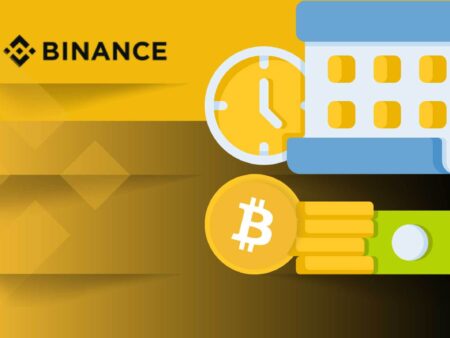Understanding Binance: A Brief Overview of the Platform
Binance is one of the largest and most popular cryptocurrency exchanges globally, providing a platform for trading a vast array of digital assets. Established in 2017, Binance has quickly gained traction due to its user-friendly interface, comprehensive trading options, and robust security measures. The platform supports a wide range of cryptocurrencies, enabling users to trade, stake, and earn on their holdings.
The exchange offers various services, including spot trading, futures trading, and margin trading. Additionally, Binance has its own native cryptocurrency, Binance Coin (BNB), which users can utilize to pay for transaction fees on the platform at a discounted rate. The platform’s advanced trading tools and analytical resources make it suitable for both novice and experienced traders.
Security is a top priority for Binance. The platform employs industry-standard measures, including two-factor authentication (2FA) and cold storage for the majority of user funds. Binance also has a robust insurance fund to cover potential losses from unforeseen events, providing an enhanced sense of security for its users.
Binance’s global footprint is evident, with users from various countries and a multitude of supported languages. The platform continually adapts to meet the needs of its diverse user base, offering localized services and tailored products. As such, Binance remains a go-to exchange for millions of cryptocurrency enthusiasts and traders worldwide.
However, like any financial platform, Binance has its share of complexities. Understanding how to navigate its features, particularly withdrawal processes, is crucial for users who want to convert their cryptocurrency holdings into fiat or other assets.
In this article, we will provide a comprehensive guide on how to withdraw money from Binance, covering everything from account setup to troubleshooting common issues.
Setting Up Your Binance Account for Withdrawals
Before you can withdraw any funds from Binance, it is essential to ensure that your account is properly set up. First, users need to create an account on the platform. This involves providing some basic personal information, such as an email address and a password. Once you submit this information, Binance will send a verification email to confirm your identity.
After verifying your email, the next step is to secure your account. Binance strongly recommends enabling two-factor authentication (2FA) for added security. 2FA typically involves linking your Binance account to an authenticator app on your mobile device, which generates time-sensitive codes to confirm your identity during login and withdrawal processes.
Following the security setup, it is advisable to complete your identity verification (KYC) process. KYC (Know Your Customer) is a standard procedure in the financial industry to prevent fraud and meet regulatory requirements. To complete this process, you will need to provide a government-issued ID, such as a passport or driver’s license, and possibly a selfie for verification.
Once your KYC is approved, you can deposit funds into your Binance account. This can be done via bank transfer, credit card, or by transferring cryptocurrencies from another wallet. It is important to ensure that your account is fully funded before attempting to make withdrawals.
Additionally, keep in mind that Binance may have specific requirements based on your region. Some countries may have additional regulatory requirements, so check Binance’s support documentation for your jurisdiction.
Lastly, familiarize yourself with the withdrawal limits and fees associated with your account type. This information will help you plan your withdrawals effectively and avoid any surprises during the process.
Step-by-Step Guide to Initiating a Withdrawal Request
Once your account is set up and verified, initiating a withdrawal request on Binance is a straightforward process. To start, log into your Binance account and navigate to the “Wallet” section located in the top menu bar. From there, select “Fiat and Spot” to view your available balances.
- Choose the Cryptocurrency to Withdraw: Look for the specific cryptocurrency you wish to withdraw from your account. Click on the “Withdraw” button next to the corresponding asset.
- Enter Withdrawal Details: In the withdrawal form, input the address where you want to send your cryptocurrency. This could be a wallet address from another exchange or a private wallet. Make sure to double-check the address, as sending to the wrong address could result in a permanent loss of funds.
- Specify the Amount: Enter the amount of cryptocurrency you want to withdraw. Binance will typically show you any applicable fees for the transaction, which will be deducted from the total withdrawal amount.
After you fill out this information, review the details carefully before proceeding. Binance will often provide a confirmation screen summarizing your withdrawal request, allowing you to double-check everything is correct.
Once you confirm the withdrawal, Binance may ask you to complete a verification step, usually involving a 2FA code. After entering the code, your withdrawal request will be submitted for processing.

It is important to remember that cryptocurrency transactions can take varying amounts of time to process depending on network congestion and the type of cryptocurrency being withdrawn. Always check the estimated withdrawal times provided by Binance for the specific asset.
Finally, you can monitor the status of your withdrawal by visiting the “Transaction History” section within the “Wallet” interface. Here, you will find details on your withdrawal requests, including timestamps and transaction IDs.
Choosing the Right Withdrawal Method for Your Needs
Selecting the right withdrawal method on Binance largely depends on your individual needs and circumstances. The exchange supports multiple withdrawal options, including bank transfers, credit/debit cards, and cryptocurrency withdrawals.
- Cryptocurrency Withdrawals: This is the most common method for those looking to move digital assets to another wallet. Users can withdraw various cryptocurrencies, including popular options such as Bitcoin (BTC), Ethereum (ETH), and Binance Coin (BNB). Withdrawals in cryptocurrencies can be processed relatively quickly, depending on network conditions.
- Fiat Withdrawals: If you prefer to convert your cryptocurrency holdings into fiat currency, Binance allows you to withdraw funds directly to your bank account or credit card. This process may take longer due to bank processing times and potential verification steps. Ensure that you have completed the necessary KYC processes to facilitate fiat withdrawals.
- Third-Party Payment Services: Additionally, Binance supports withdrawals through various payment services like PayPal or other payment processors, depending on your location. Before choosing this method, check the availability and associated fees.
When selecting a withdrawal method, consider factors such as processing times, fees, and convenience. Cryptocurrency withdrawals generally have lower fees compared to fiat withdrawals, making them a preferred option for many traders.
It is also essential to understand the limits associated with each withdrawal method. Different methods may have varying minimum and maximum withdrawal limits, which can impact your ability to access your funds.
Always stay informed about the latest withdrawal options and updates from Binance, as the platform frequently expands and modifies its services to cater to user needs.
Navigating Fees and Limits on Binance Withdrawals
When withdrawing funds from Binance, it’s crucial to be aware of the fees and limits that may apply. Cryptocurrency exchanges typically impose withdrawal fees, which can vary depending on the asset being withdrawn. Binance is known for its competitive fee structure, but users should still familiarize themselves with the specifics.
Withdrawal Fees:
- Fees for cryptocurrency withdrawals are calculated based on the network’s transaction fees, which fluctuate depending on market conditions.
- Binance also publishes a list of standard withdrawal fees for each cryptocurrency, allowing users to plan their withdrawals accordingly.
- Knowing the fee structure enables users to avoid unexpected deductions from their withdrawal amounts.
Withdrawal Limits:
- Binance sets minimum and maximum withdrawal limits based on several factors, including the user’s account verification level and the withdrawal method chosen.
- For unverified accounts, withdrawal limits may be significantly lower, encouraging users to complete the KYC process for higher limits.
- Users can usually find their specific withdrawal limits by checking their account settings or the Binance support page.
To help users understand the fee and limit structure for various withdrawal methods, here is a comparison table:
| Withdrawal Method | Typical Fees (in %) | Minimum Withdrawal Limit | Maximum Withdrawal Limit |
|---|---|---|---|
| Cryptocurrency Withdrawal | Network fees apply | Varies by asset | Varies by asset |
| Bank Transfer (Fiat) | Flat fee (varies) | $100 | $20,000 |
| Credit/Debit Card | Flat fee (varies) | $50 | $10,000 |
Understanding these fees and limits helps users make informed decisions and plan their withdrawals more effectively. Users should also check the Binance support page regularly for updates on fees, as changes can occur based on market conditions and regulatory considerations.
Troubleshooting Common Withdrawal Issues on Binance
Even with a well-setup account, users may encounter withdrawal issues on Binance. Here are some common problems and troubleshooting tips to address them.
- Address Errors: One of the most frequent issues is entering an incorrect withdrawal address. Always double-check the address before submitting your request. If you realize you’ve made a mistake, contact Binance support immediately, although recovery is not always guaranteed.
- KYC Verification Delays: If your account is not fully verified, you may face withdrawal limitations. Ensure that you have completed all required KYC steps. If your KYC verification is pending for an extended period, reach out to Binance support for updates.
- Network Congestion: Cryptocurrency withdrawals can be delayed due to network congestion. If your withdrawal is taking longer than expected, check blockchain explorers for transaction status. You can also refer to Binance’s status page for updates regarding network performance.
- Insufficient Funds for Fees: Sometimes users overlook withdrawal fees, leading to insufficient funds for the transaction. Always ensure that you have enough balance, factoring in the withdrawal fee before submitting.
- Account Restrictions: Binance may impose restrictions on accounts due to security reasons or regulatory requirements. If you are unable to withdraw, check your account notifications for any messages from Binance regarding restrictions.
- Technical Glitches: Occasionally, users may experience technical issues on the platform. If you encounter any glitches while attempting to withdraw, try logging out and logging back in, or clear your











Thanks for explaining how to withdraw funds from Binance. The step-by-step guide is helpful.
I wasn’t aware of the insurance fund on Binance, adding an extra layer of security for users.
Good to know that Binance has a native coin, BNB, which offers fee discounts.
It’s interesting that Binance adapts to different countries with localized services.
The article explains Binance really well. It seems like a big platform with lots of options.
Understanding the fees and limits on withdrawals is crucial. Thanks for the detailed explanation!
I didn’t know Binance was so secure with 2FA and cold storage. That’s reassuring!
Binance seems user-friendly with its advanced trading tools and resources for traders.
The article mentions multiple withdrawal methods. It’s nice to have options like bank transfers and crypto withdrawals.
I learned that completing the KYC process is important for higher withdrawal limits on Binance.